Tested: 2021 Ram 1500 TRX vs. 2020 Ford F-150 Raptor SuperCrew
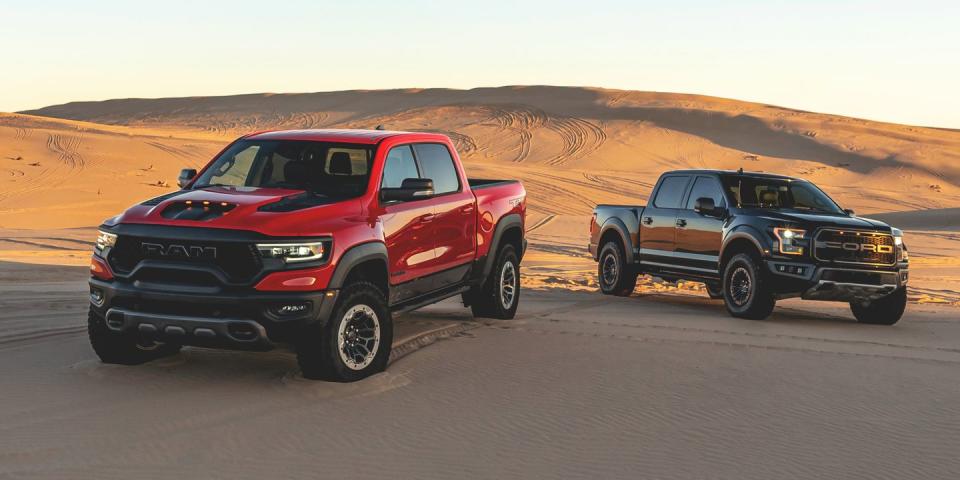
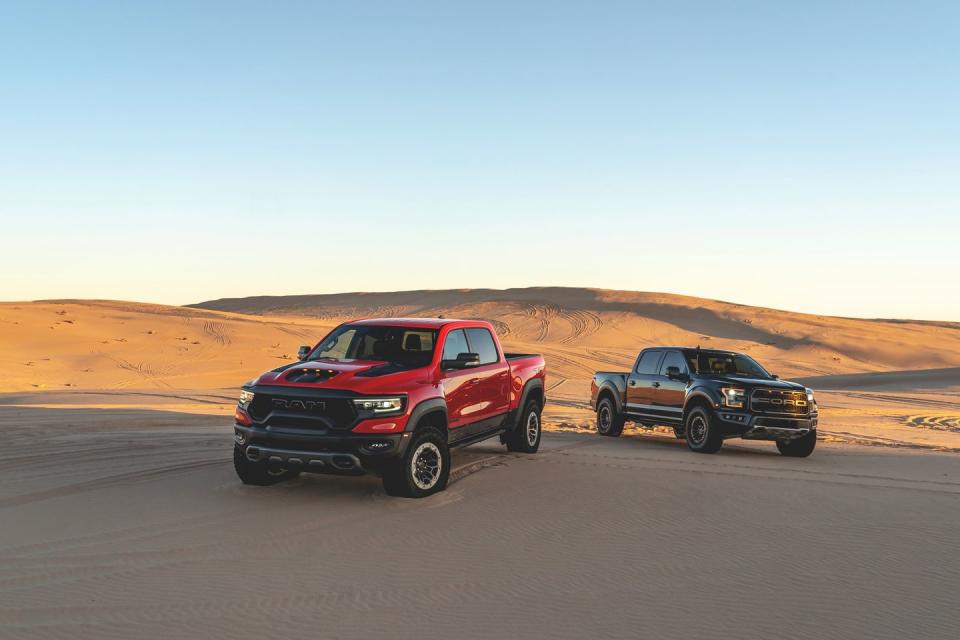
From the December 2020 issue of Car and Driver.
There are no gentlemanly duels in the truck wars. From torque outputs to tow ratings, the evolution of the pickup plays out in slugfests of one-upmanship. That has made the Ford F-150 Raptor's decade-long reign as the undisputed champ of high-performance production off-road trucks an impressive feat. While tamer Chevys, Jeeps, and Toyotas have deepened the factory off-road pool over the years, Ram's new 1500-based TRX is the first contender with a real shot at unseating the Raptor from the lofty throne it created.
One look under the hood of the TRX—which Ram internally calls "T. rex"—reveals the seriousness of this bout: From Fiat Chrysler's Hellcat line, this supercharged V-8 makes 702 horsepower and, at 6.2 liters, simply dwarfs the Raptor's 450-hp twin-turbo 3.5-liter V-6. To deflate Ford's EcoBoost further, under the Ram's airbox cover lurks an image of the TRX's Cretaceous-period inspiration with a velociraptor in its mouth.

Similar to the Raptor, the TRX has been fortified for its mission with a reinforced ladder frame, massive suspension pieces, and a robust full-time four-wheel-drive system. Both trucks roll on knobby all-terrain tires nearly three feet tall, which can cycle through more than a foot of suspension travel with the help of beefy adaptive dampers with external reservoirs. The main difference here is that the TRX's rear axle is held in place by links and sprung with coils versus the Raptor's leaf-spring arrangement—a design one might call prehistoric. Although both trucks resemble their workaday siblings and can be had with almost as many amenities, their significantly widened tracks and aggressively flared bodywork make them impossible to miss on the road.
The TRX's big engine and crew-cab-only configuration make it a pricey proposition, at $71,790 to start, but you have to remember that figure is attached to the most powerful factory pickup ever. Numerous options inflated our truck's as-tested price to $89,565, with $7920 of that coming from Ram's Level 2 Equipment Group of luxury and convenience features.
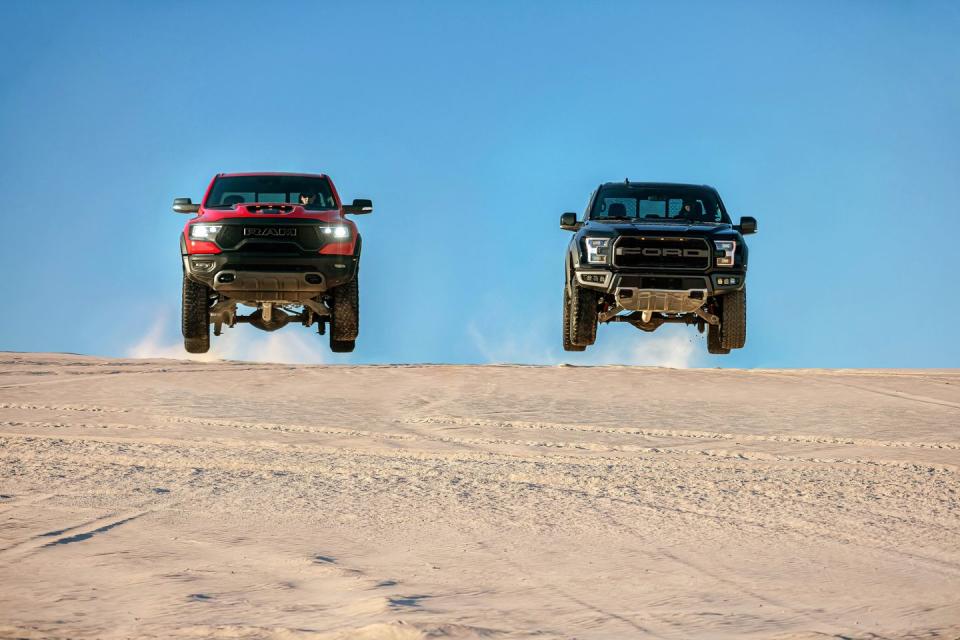
The F-150 Raptor, on the other hand, is a relative bargain considering its sheer badassery. It starts at $55,150 in extended-cab form. We asked Ford to lend us the bigger crew-cab version, which starts at $58,135, but it wasn't "available." (Ford PR likely hoped we would wait to conduct this comparo until their next-gen Raptor arrived with an updated interior, rear coil springs, and a rumored blown V-8.) Instead, we rented a 2020 SuperCrew with $15,655 worth of options from a brave man named James Lyons. Including the comprehensive $10,920 Equipment Group 802A Luxury option (nav, 360-degree camera, Bang & Olufsen sound system, etc.) that seemingly all new Raptors have, the as-tested price came to $73,790.
Our matchup began at the test track and then headed west from Ann Arbor over highways and back roads to the towering coastal sand dunes of Michigan's Silver Lake State Park—a public space where you can fully unleash these trucks. Set free to roam the 450 acres of hills, jumps, and open expanses, we examined both trucks in their intended environment. One would be crowned the ultimate off-road production pickup. The other's ego would be battered. Let the fight begin.
2nd Place:
Ford F-150 Raptor SuperCrew
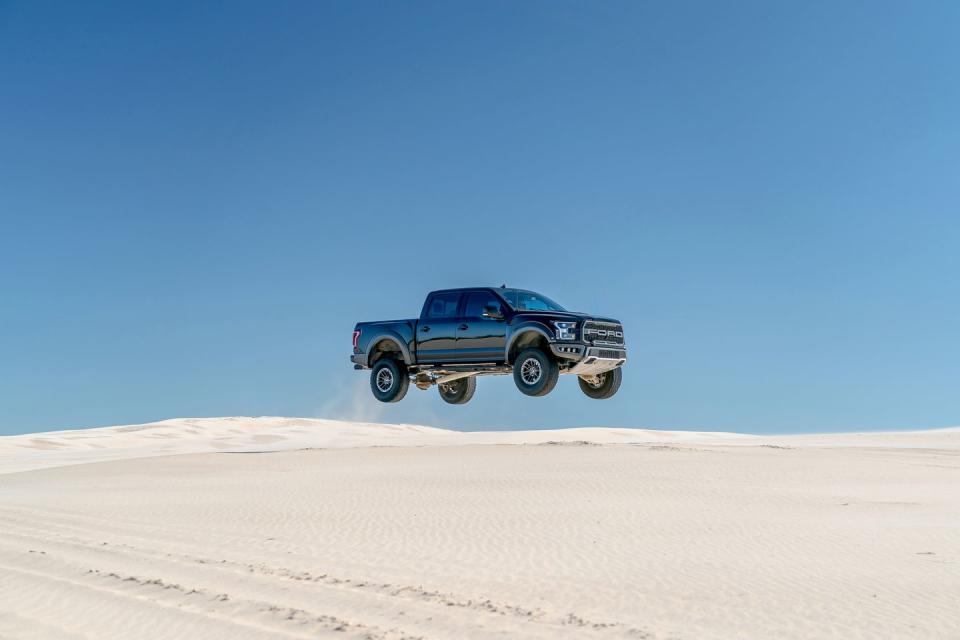
Highs: Insanely capable off-road, plenty quick, attractive base price.
Lows: Uninspiring twin-turbo V-6, floppy handling, prone to rear-axle hop, dated cabin.
Verdict: Ford's hardcore F-150 needs to go back to the gym.
We've spent enough time with the current Raptor to respect how empowering it is to drive. It feels close to invincible and looks appropriately menacing. With 86.3 inches between the fenders, it seems to hug lane lines like an 18-wheeler. And yet our test truck's 5.3-second run to 60 mph is darn quick for any pickup. It takes a lot to make Ford's burliest F-150 seem dainty, but that's exactly what the TRX does.
The Raptor has no hope of winning a drag race against the supercharged Ram, requiring a whopping 5.3 seconds longer to reach 100 mph. At rest, you can hardly tell that its engine is running if a TRX is in the vicinity. The Ford actually produces more noise inside at full throttle—83 decibels to the Ram's 80—but the flat, synthesized thrum of its V-6 is wholly unsatisfying.
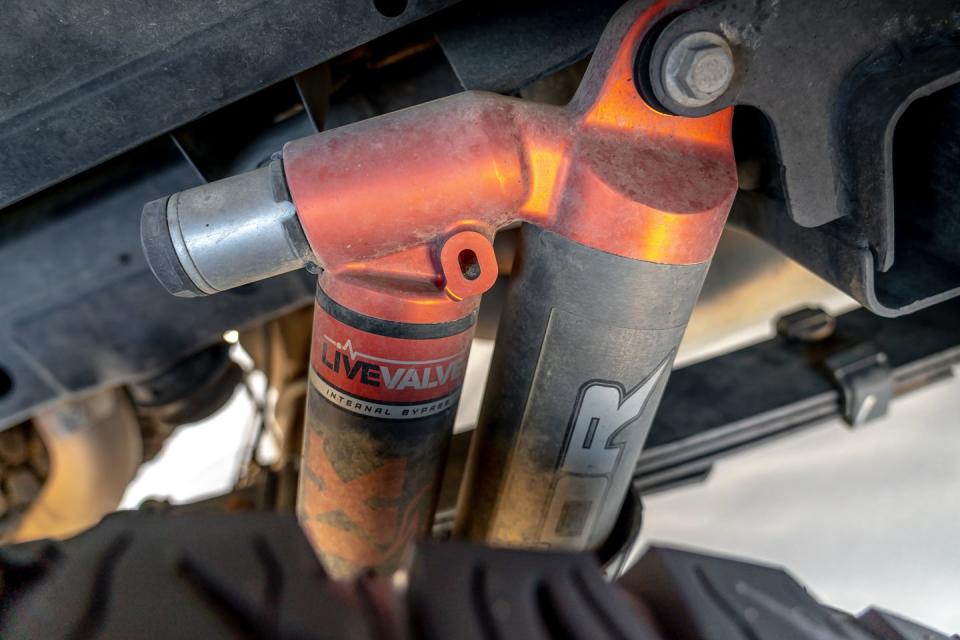
While both of these softly sprung trucks return good ride comfort on any type of pavement, the Raptor's handling is sloppier. The adaptive Fox Racing dampers that were added for 2019 do a commendable job of managing the 34.4-inch-tall BFGoodrich All-Terrain T/A KO2 tires hanging off its long-travel suspension (13.0 inches up front, 13.9 in the rear). But even with the dampers in their firmest setting, the Raptor leans and wobbles around corners, always feeling unsettled. The enormous footprint provides some stability, but the 4E-wide shoes manage just 0.72 g of skidpad grip on pavement—0.02 g more than the TRX—and are likely a key factor in the vague, artificial steering feel. Large midcorner bumps produce both shakes from the Ford's frame and shudders from its rear axle.
Our test truck performed slightly better in the sand dunes. Aided by an electronically locking rear differential, an optional Torsen limited-slip front diff, and an array of chassis and drivetrain systems that tie into the Baja and Mud/Sand drive modes, the Raptor is a touch nimbler than the Ram at speed. Its in-flight attitude is better balanced, and its ability to soak up big landings without bottoming out never fails to impress.
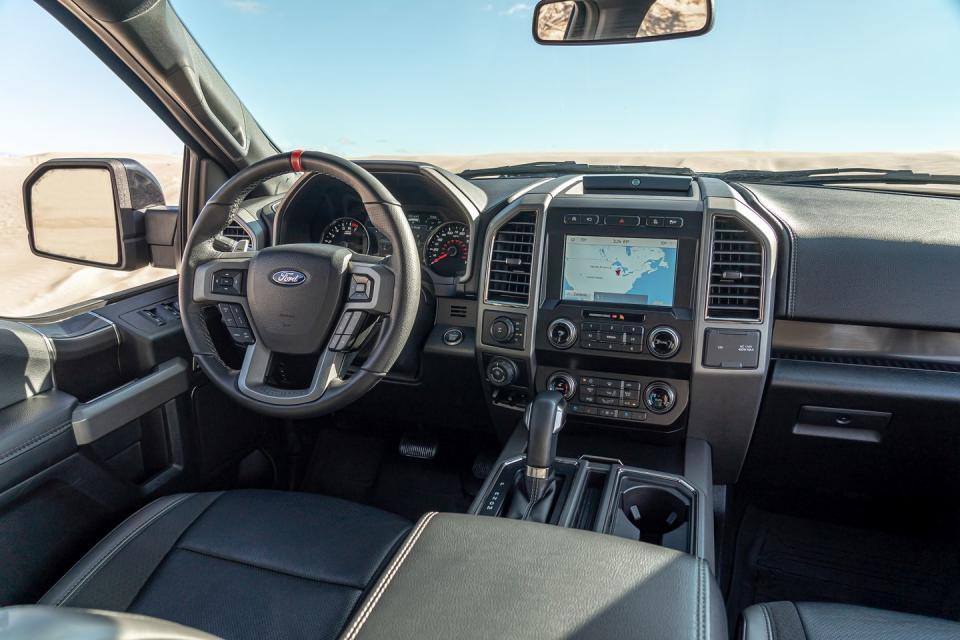
But the Raptor also had to work extra hard to keep up with the TRX. In the soft, power-sapping sand, it had some trouble. The V-6's 510 pound-feet of torque seemed to come in surges, which caused Ford's 10-speed automatic transmission to occasionally stumble as it jockeyed gears to keep the engine in its sweet spot. Significant rear-axle hop robbed the Raptor of precious traction and momentum on steep dunes. But even when the truck found purchase, its engine often just couldn't keep the wheels spinning as hard as we wanted. More than once the Raptor got caught between gears and lost boost while the TRX roared up the same hill with power to spare.
We admit that most owners will never push these trucks as hard as we did. To the vast majority of drivers, a Raptor unleashed in its element is an otherworldly experience. But every reign must come to an end.
1st Place:
Ram 1500 TRX
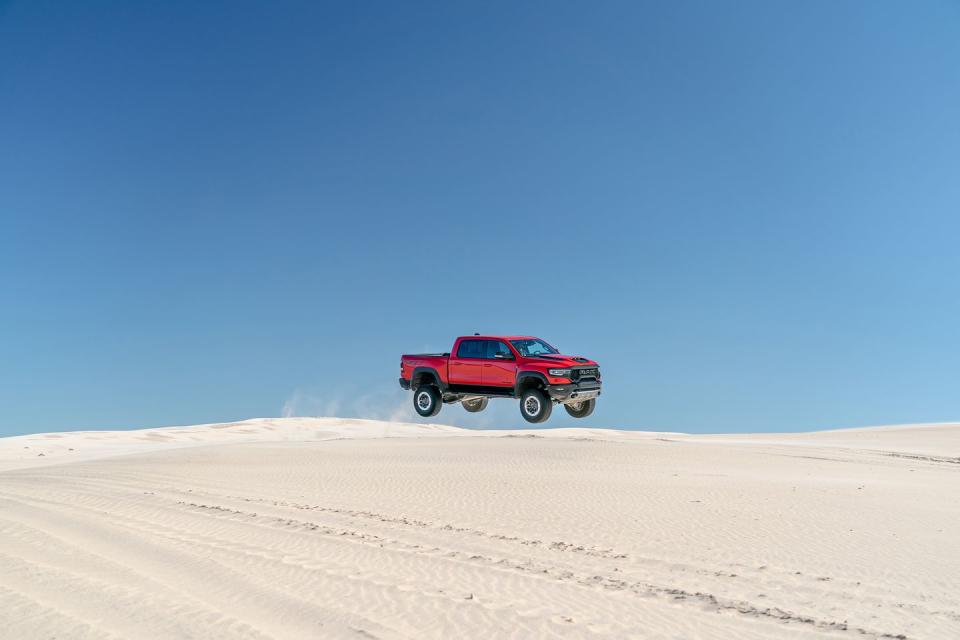
Highs: Intoxicating V-8 power and noise, impressively flexible suspension, a Ram 1500 at its core.
Lows: Even bigger than the Raptor, voracious thirst, no rear-drive setting.
Verdict: The quickest, most powerful production pickup ever.
Even in the company of the Raptor, the TRX is a vehicle of extremes. The Ram stands more than two inches taller than the Ford and is 1.7 inches wider. Its Goodyear Wrangler Territory AT tires are wider and taller than the Ford's BFGs, too. And weighing in at 6866 pounds—869 more than the Raptor—the TRX is as dense as a locomotive, but we're not complaining, because its strengthened frame feels rigid enough to support all that bulk.
The TRX's centerpiece is the Hellcat V-8, which handily shrugs off the truck's mass with the help of ZF's heavy-duty eight-speed automatic. Engage launch control on pavement and the behemoth Ram rockets to 60 mph in an absurd 3.7 seconds—quicker than a Toyota Supra 3.0 that weighs less than half as much. The TRX's 110-mph pace at the end of its 12.3-second quarter-mile run is both 13 mph greater than the Raptor's and faster than the Ford can go flat out. The noise from the big V-8 is just as impressive. From its supercharger whine to its deep idle that can be felt inside nearby buildings to its diabolical full-throttle roar, the TRX is drunk on power. Fuel economy is as horrendous as you'd expect; we averaged just 9 mpg on our mostly highway adventure, including a mere 4 mpg in the dunes.
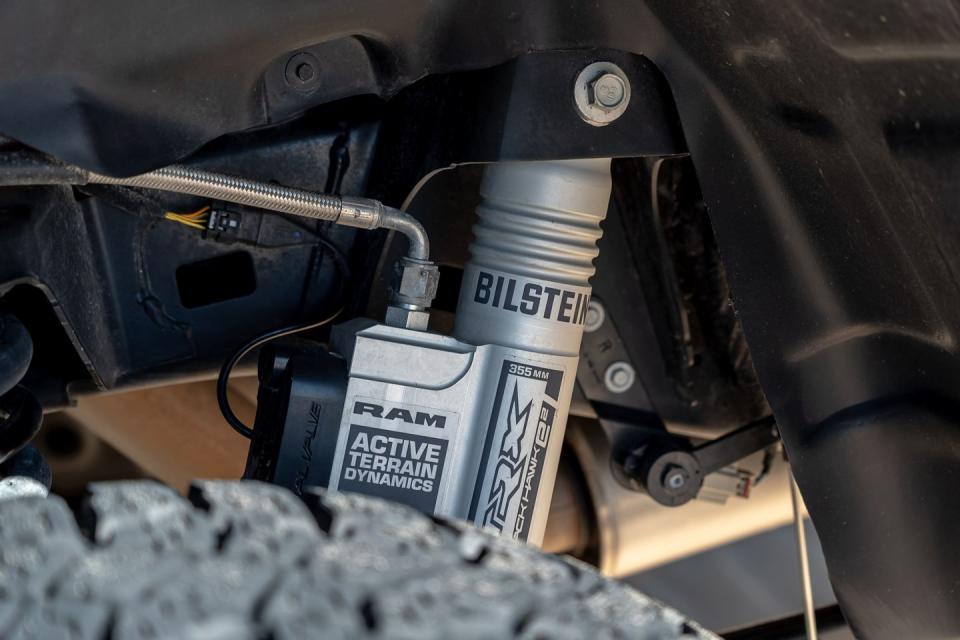
That the TRX maintains most of the regular Ram 1500's interior comfort and on-road refinement is shocking. Much of the credit goes to its all-coil-spring suspension, which has essentially the same amount of travel as the Ford's setup yet employs adaptive Bilstein dampers that deliver a better ride. They are slightly firmer than the Raptor's dampers in their normal setting and notably more so in Sport mode, which results in better body control around corners. "It's amazing how a truck this large, heavy, and off-road oriented can be placed so precisely on a challenging paved road," observed testing director Dave VanderWerp. The TRX has more linear steering and stronger braking performance from 70 mph—189 feet versus 195 for the Raptor.
We initially weren't sure how well the TRX's brute-force approach would work off-road. It's a little trickier to jump than the lighter Raptor, but Baja mode softens its dampers considerably to absorb big impacts. Considering the Ram's extra mass, we never would have thought the TRX could smooth out high-speed whoop-de-doos better than the Raptor, but it does.
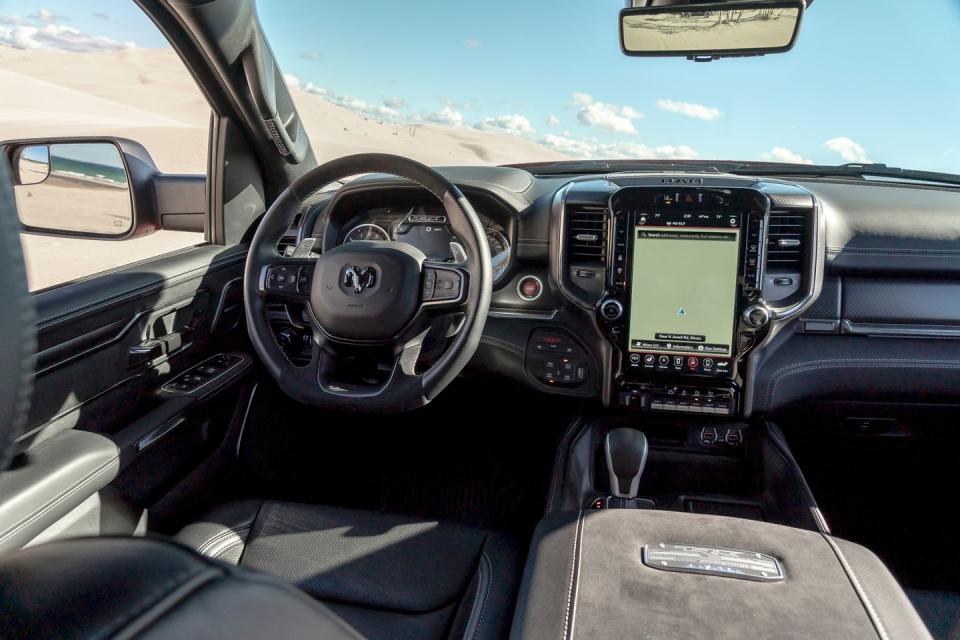
Quick launches required some throttle modulation to keep the Ram from spinning its tires and burrowing into the sand on the spot. But once we got the truck moving, the eight-speed automatic managed the Hemi's full 650 pound-feet of torque with impressive quickness and smoothness. On flat sand, the TRX clawed to 60 mph in 8.8 seconds and reached an indicated 90 mph; the Raptor took 11.3 seconds and never approached that speed. Steeper-than-expected hillsides were quickly dispatched with the flex of a right foot, the TRX downshifting and throwing sand from all four Goodyears with almost none of the abusive axle hop that plagues its rival.
Our gripes are few: We wish we could vaporize the TRX's rear tires in a two-wheel-drive mode like the Raptor has, but it offers only 4WD Auto, 4WD High, and 4WD Low settings. We'd also like a limited-slip front differential to go with the standard rear locker; the current setup uses the brakes to mimic a limited-slip front diff, and this truck's stoppers already have enough work to do. And while the Ram's cabin is high tech and more finely trimmed than the F-150's, some of the controls could be more responsive and easier to use, such as the laggy drive-mode buttons on the dash and the forked paddle shifters that straddle audio buttons on the back of the steering wheel.
Annoyances aside, the TRX is an outrageously capable effort based on the best half-ton pickup currently available, and so we never questioned its price. Ram took the idea of the bonkers off-road truck to the next level, and that's what makes the TRX the new champ.

You Might Also Like

 Yahoo Autos
Yahoo Autos 